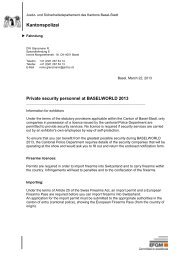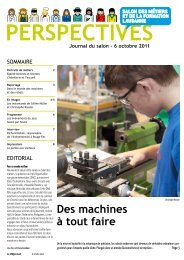WatchTime - August 2012
WatchTime - August 2012
WatchTime - August 2012
Create successful ePaper yourself
Turn your PDF publications into a flip-book with our unique Google optimized e-Paper software.
CLOSE-UP<br />
Patek Philippe Reference 5204<br />
A BRIEF HISTORY OF SPLIT-SECONDS CHRONOGRAPHS<br />
Dubey & Schaldenbrand’s Index Mobile Winnerl’s pocketwatch No. 495 (circa 1840).<br />
The flyback pusher is on the pendant.<br />
Chronographs with a split-seconds or<br />
“catch-up” hand (French: rattrapante) are<br />
much rarer and more expensive than<br />
“ordinary” chronographs. In a split-seconds<br />
chronograph, the second elapsedseconds<br />
hand can be stopped as often as<br />
desired and independently of its twin,<br />
enabling the user to measure intermediate<br />
times. After each intermediate interval’s<br />
duration has been read, the stopped<br />
hand can be restarted and it speedily<br />
catches up with its counterpart (i.e., the<br />
chronograph’s primary elapsed-seconds<br />
hand). Both hands can also be simultaneously<br />
returned to the zero position. All<br />
this requires an additional, costly mechanism,<br />
so the price of a rattrapante watch<br />
is generally about 50 percent higher than<br />
that of an ordinary chronograph.<br />
The first rattrapante dates from 1827,<br />
when Louis-Frédéric Perrelet and his son<br />
were issued a patent for a split-seconds<br />
mechanism. Perrelet père et fils had connected<br />
two seconds hands at a single<br />
point of contact. The final arrangement is<br />
credited to the Austrian watchmaker<br />
Joseph Thaddäus Winnerl, who moved to<br />
Paris in 1829 and two years later developed<br />
the mono-rattrapante, which had a<br />
catch-up mechanism equipped with only<br />
one hand. A version with two seconds<br />
hands followed in 1838. A return-to-zero<br />
mechanism had not yet been invented.<br />
56 <strong>WatchTime</strong> <strong>August</strong> <strong>2012</strong><br />
Genuine split-seconds chronographs<br />
in pocketwatches first appeared in 1883.<br />
In 1921, Ralco SA, a sub-brand of Movado<br />
in La Chaux-de-Fonds, unveiled what was<br />
probably the world’s first split-seconds<br />
chronograph in wristwatch form. Luxury<br />
brands including Patek Philippe followed<br />
suit several years later. The complex and<br />
laborious task of manufacturing a rattrapante,<br />
along with the consequent high<br />
price, dissuaded experienced ébauche<br />
manufacturers from producing split-seconds<br />
versions of common calibers. The<br />
first to do so was Valjoux, the industry<br />
leader, in movements measuring 39.3<br />
mm in diameter (17 2/3 lignes). Smaller<br />
14-ligne models were available from<br />
Venus’s Caliber 185 in a<br />
Record watch (ca. 1950)<br />
Bovet’s Mono-Rattrapante<br />
Venus, which made Caliber 179 (with<br />
elapsed-minute counter, 7.2 mm tall),<br />
Caliber 185 (with counters for elapsed<br />
minutes and elapsed hours, 8.55 mm tall),<br />
Caliber 189 (identical to Caliber 185, but<br />
with a pointer date display, 8.55 mm tall)<br />
and Caliber 190 (identical to Caliber 189,<br />
but including a moon-phase display, 8.55<br />
mm tall). None of these calibers achieved<br />
widespread popularity. Nor did Bovet’s<br />
Mono-Rattrapante, which debuted in<br />
1936, or Dubey & Schaldenbrand’s comparatively<br />
simple index-mobile construction<br />
(starting in 1946), in which a slender<br />
coiled spring, visible above the dial,<br />
caused the split-seconds hand to jump<br />
back.<br />
It wasn’t until 1988, when the mechanical<br />
renaissance was underway, that<br />
there was a noteworthy breakthrough.<br />
That’s when Frédéric Piguet and Blancpain<br />
launched the caliber duo 1181<br />
(hand-wound) and 1186 (automatic). In<br />
1992, Chronoswiss, IWC and Ulysse<br />
Nardin each upgraded Caliber Valjoux<br />
7750 with a split-seconds mechanism,<br />
and Breguet launched the 533 NT, based<br />
on a Lémania mechanism. A. Lange &<br />
Söhne introduced the Double Split (Caliber<br />
L001.1) in 2004: this was the world’s<br />
first chronograph with split hands for<br />
both the elapsed seconds and the<br />
elapsed minutes.

















